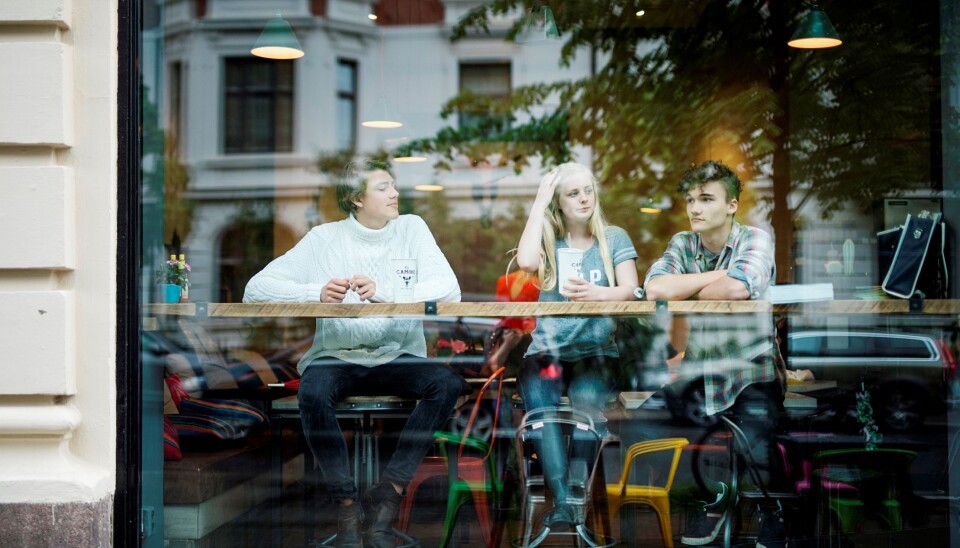This article was produced and financed by Oslo Metropolitan University

Oslo is a divided city
Young people who live on the west side of Oslo have better health, are happier and live a healthier and more active life than youth living elsewhere in Oslo.
There are major differences between young people in the city of Oslo. Those with backgrounds from the higher social strata score higher on several indicators. Elsewhere in Norway, young people's social background is also very important to their quality of life and participation in many areas.
This is shown by the most recent Ungdata surveys from 2014 and 2015, carried out in 187 municipalities and three counties. More than 115,000 young people took part in the surveys.
"We see that there are social differences in many areas in young people's lives, including health, exercise habits, diet and school," says researcher Anders Bakken from NOVA – Centre for Welfare and Labour Research at Oslo and Akershus University College of Applied Sciences (HiOA).
"Although Norway is a country characterised by a strong equality ideal and the financial differences in Norwegian society are relatively small, young people's social background is important to their quality of life and their participation in many areas," he says.

"These differences will probably affect their future living conditions and possibilities in Norwegian society."
Parents with money
Bakken summarises the economic development as follows: Young people born in the 1990s grew up in a situation where their parents had more and more money to spend.
It is has become easier to get loans, which has contributed to most parents being able to buy things that were unthinkable only a generation or two ago. Low interest rates also helped to make life easier for debt-ridden families.
At the same time, there has been an increase in income inequality, and, like in other countries, the differences between rich and poor people have increased in Norway. The number of poor children has also increased, and part of the reason for this is increased immigration.
"Analyses of data from the Ungdata survey show that there are systematic differences in terms of reported quality of life between young people in the different financial categories."
"In a nutshell, young people who feel that their family is short of money are generally less satisfied with their life than other young people, and they are usually less happy with their parents, friends and local community," says the NOVA researcher.
At the same time, fewer young people with backgrounds from the lower social strata are motivated for school and higher education, and they participate less in organised leisure activities.
Young people in families with little money also score poorly on many of the health indicators mapped through Ungdata. They are less satisfied with their own health, more frequently have symptoms of depression, more rarely eat regular meals, and fewer of them exercise than young people in families with more money.
"Arguing with their parents is more common among young people in the lower social strata, and more of these young people say that they try to hide much of what they do in their free time from their parents," says Bakken.
"More young people in the lower social strata find their parents far too strict."
Ungdata also shows a clear connection between feeling that the family is short of money and risk factors relating to alcohol and drug use, crime, bullying and violence.
Oslo remains a divided city
The most recent youth survey, Young in Oslo 2015, concluded that, on average, Oslo is not very different from the rest of Norway. The majority have good relationships with their parents and friends, enjoy school, are active outside school and are satisfied with their own health. The use of alcohol and drugs is at an all-time low.
At the same time, the survey shows that there are considerable geographical differences between young people in the city.
Young people in the eastern and central city districts are the least happy with their parents, and they are also most dissatisfied with their local community and have fewest friends.
Young people in the western city districts, on the other hand, are more satisfied with their health than young people in other parts of the city. They exercise more, and more of them take part in organised leisure activities.
The outer eastern city districts have the lowest level of exercise, whereas young people in the central districts participate less than others in organised leisure activities.
Social differences in school performance
As regards plans for education, far more young people from the west side aim to take higher education.
"There are big differences in grades between young people from different backgrounds. More young people in the lower social strata say that they are bored at school, and more dread going to school," Bakken emphasises.
Young people from lower social strata also spend more time watching TV, playing computer games and using social media.
In many areas, young people from immigrant backgrounds are not very different from other young people in Oslo. However, there are three areas where an immigrant background is highly significant: Young people from immigrant backgrounds drink far less alcohol, and they spend more time on homework and less on exercise and organised leisure activities.
"In fact, children of non-western immigrants seem to transcend some of these traditional class mechanisms. They are highly motivated for education, and take higher education to a greater extent than their classmates from the same social background," he adds.
Not one explanation
Bakken emphasises that there is probably not one single underlying factor that can explain all of these social patterns. He believes that there are different explanations in the different fields, and that this makes it more complex and difficult to understand the connections.
"But generally speaking, it is important to facilitate good and inclusive local communities in which young people can express themselves and are given an opportunity to participate in many arenas," says Bakken.
"Supporting clubs and associations can be one strategy. Another potential strategy is to make the schools even more inclusive and perhaps also provide homework assistance targeting the pupils who need it the most."
"I'm not sure that direct financial support to families is the most important measure. This is an instrument that can be used in relation to the very poorest families, but other measures are probably more effective in reducing social inequality. Finally, I would like to emphasise the importance of good child welfare measures," he adds.
-------------------------------------
Read the Norwegian version of this article at forskning.no

































